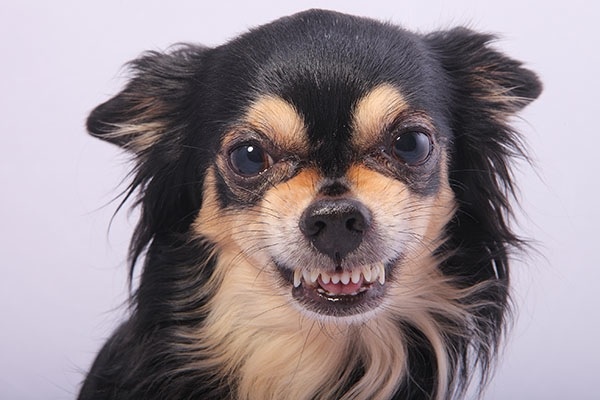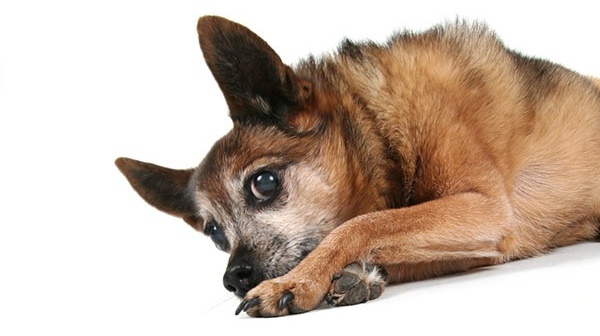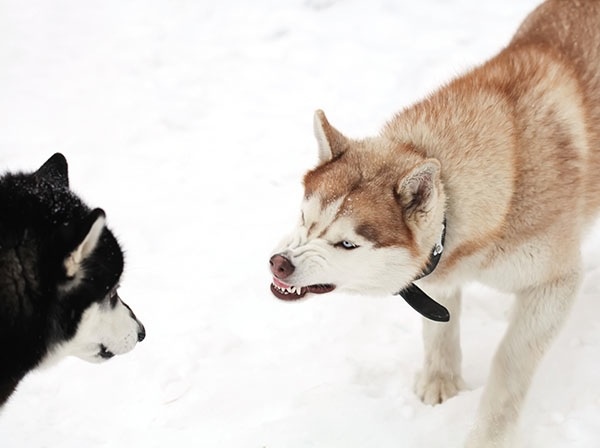Chapter 17: Aggression
Aggression can be one of the most heart-wrenching, frustrating, and frightening issues to experience with your dog. It’s so upsetting that many people live in denial about their dog’s aggression until the problem escalates to where they can’t ignore it any more. Excuses abound, from “He must have been abused before we got him, so he doesn’t like men” to “He didn’t mean to bite me, and I could tell he regretted it.” Puppies are not that good at gauging the damage that their teeth can do, but adolescent and adult dogs are. When a dog uses his teeth to make a point, it’s not an accident. He means it. Dogs have exquisite control over their teeth and can move lightning fast. You are not quick enough to get out of the way. If your dog snaps and misses, he meant to miss. If he bites, he meant to bite.
Aggression takes several forms. Growling is a form of aggression. If your dog growls over a bone or his place on the bed, it’s aggression. If he growls when your child approaches, it’s aggression. Barking and lunging can be signs of aggression. When the fur rises on your dog’s shoulders and back, called piloerection, it can be a sign of aggression. Snapping and biting are signs of aggression.

Never punish a dog for growling, as it’s valuable communication.
Get Help!
If your dog exhibits these behaviors, do not wait to get help. Aggression does not go away on its own; more often, it worsens the longer it goes on. The best practice is to get professional help because aggression is complicated to resolve and has tremendous liability issues. Choose a professional trainer who uses only reward-based methods, not the old-fashioned choke chains, prong collars, or electric collars, or the outdated “dominance theory,” which can make aggression much worse.
Choose a professional trainer who has proven experience and education in dealing with aggressive dogs—interview the trainer carefully to ensure that he or she is qualified. A professional trainer can ensure that you are following the behavior-modification program properly. If there are children involved, please contact a veterinary behaviorist or a Certified Applied Animal Behaviorist (CAAB). An animal behaviorist is different from a regular trainer, even a trainer with great credentials.
Children and dogs can be a beautiful team—or a trip to the emergency room. If your dog growls at your children, then do not hesitate to get help. Ask your veterinarian for a referral to a veterinary behaviorist or a CAAB today. You may have to travel to find one, but many also offer Skype and phone consultations.
There are some general tips to keep in mind when dealing with aggression.
•Recognize it as aggression and admit that there is a problem. It is hard to admit that your dog may not be perfect or may even be “mean.” But admitting a problem is always the first step to fixing it. Just because your dog may growl over toys or snap at your boyfriend doesn’t mean that he is a bad dog. It also doesn’t mean that your only option is euthanasia, which is at the heart of many people’s concerns. With the surge in positive training methods over the last decade, there are more solutions than ever to help aggressive dogs.
•Do not punish your dog for growling. This is a common mistake. You don’t want your dog to growl, so you punish him for it. You’re embarrassed when he growls, so you punish him for it. Big mistake. A growl is a warning. Your dog is telling you that he is upset about something. If you punish him for growling, you could successfully stop him from doing so … but you haven’t eliminated the thing that he’s upset about in the first place. So, in effect, you’ve eliminated the warning system. Never punish your dog for growling. You want to know when he’s upset! It’s better to hear about it in a growl than for your dog to feel that he needs to go straight to a bite.
•Do not use harsh physical punishment. You’ve already read about the consequences of physical punishment. They are even more pronounced in aggression cases. Do not treat aggression with aggression, as you will likely make the problem much worse.
If you shouldn’t use physical punishment to “correct” your dog, what can you do? There are extremely helpful tools that you can use, depending on what type of aggression you are dealing with.

Most aggression is based on fear.
Territorial Aggression
Territorial aggression occurs when a dog is protecting an area that he considers his. Some dogs will attack and bite a person who enters the home. Others will act aggressively when anyone enters the yard. Others are territorial about vehicles or their crates. Studies have shown that dogs that are chained in yards have an increased amount of territorial aggression.
Some people like it when their dogs are territorial, but this is a slippery slope. A dog does not automatically know who is a bad person and who isn’t. If your dog is protecting your home by acting aggressively, he is just as likely to act that way toward your neighbor’s daughter who comes to visit as he is toward a criminal.
Different areas have different laws about whether you will be liable if your dog bites or injures someone when they are on your property. Don’t assume that you will not be held responsible; check your local area’s ordinances. Even if the law says you’re in the clear, you would feel awful if an innocent person was injured by your dog.
Some people think that their dogs are exhibiting territorial aggression when, in fact, they are actually scared of people. The dog is barking and growling not because he wants to protect his property, but because he thinks that people are scary and wants them to go away. How can you tell the difference? The dog will normally exhibit the same territorial behavior elsewhere, in areas other than what you would consider his “home turf.”
If your dog is exhibiting territorial aggression, management is your best tool until you can implement a behavior-modification program with a professional trainer. Ensure that your fence is tall and secure, and consider putting a lock on it so unauthorized people will find it harder to enter.
Do not use an underground fencing system. The use of electric shock is not recommended in general, but it can also cause aggressive behavior to escalate. A territorial dog’s aggressive behavior is already escalated, and the additional punishment of an electric shock can trigger an attack.
If you know that guests are coming over, confine your dog. After your guests are settled, if your dog has a history of accepting people in your home, bring your dog out on leash for extra control. Use your clicker and treats to reward relaxed, social behavior.
If your dog is protective of his crate or the car, here is how you can train your dog to have a better response than aggression.
Goal: Your dog will not exhibit aggression when people approach his crate or your car.
What You’ll Need: Treats, other people to help you.
1.Have the other person walk past the crate or car, several feet (m) away.
2.As soon as your dog sees the person, start feeding him treats, even if he growls or lunges. If he is so agitated he will not eat the treats, start over with the person farther away.
3.As soon as the person has walked by and your dog can no longer see him or her, stop the treats. Ignore your dog.
4.Repeat Steps 1–3 nineteen times. End your training session.
Tips: You are trying to change your dog’s opinion of people approaching his crate or car. This is why you feed him even if he is growling or lunging. Just rapidly feed him as long as the person is within his sight. You will find that his outbursts become less volatile as he starts to anticipate food instead of worrying about the person’s approach. This may take many sessions, depending on how long your dog has been practicing this behavior.
Did You Know? Aggressive Responses Create Aggressive Dogs
According to a veterinary study published in the Journal of Applied Animal Behavior (2009), if you’re aggressive to your dog, your dog will be aggressive, too. The highest frequency of aggression occurred in response to these interventions:
•Hitting or kicking the dog (41% of owners reported aggression)
•Growling at the dog (41%)
•Forcing the dog to release an item from his mouth (38%)
•“Alpha roll” (forcing the dog onto his back and holding him down) (31%)
•“Dominant down” (forcing the dog onto his side) (29%)
•Grabbing the jowls or scruff (26%)
•Staring the dog down (staring at the dog until he looks away) (30%)
•Spraying the dog with water pistol or spray bottle (20%)
•Yelling “no” (15%)
•Forced exposure (forcibly exposing the dog to a stimulus—such as tile floors, noise, or people—that frightens the dog) (12%)
Aggression toward People
Most aggression is based in fear. Dogs that are frightened of people often act aggressively—growling, barking, snapping, snarling, biting. Punishing your dog won’t get rid of the fear. You need to teach your dog that people are nice and are nothing to be afraid of. This must be done very carefully, and gradually, preferably with the help of a professional.
Do not force your dog to confront his fear. This will make the fear much worse. For example, if your dog is scared of men, don’t hand your dog’s leash to a man or make your dog approach a man. The man could be a wonderful person, but in your dog’s eyes, you just handed his leash over to or made him approach a monster.
If your dog is aggressive toward strangers, implement a stringent management plan until you can get professional help. Keep him away from strangers. If you have guests over, you can put him in his crate, in another room, or behind a secure baby gate so that he can’t reach your guests and become overwhelmed.
If he’s crated or behind a baby gate where you can easily reach him, you can toss treats to him while your guests are over. You can give him a bully stick or food-stuffed chew toy. Do not let your guests give him treats. A very food motivated but fearful , dog could get overwhelmed, so he will approach a stranger to take a treat but then become overwhelmed by the proximity. This can lead to a bite.
The Miracle of Muzzles
Muzzles get a bad rap. It’s true that when people see your dog wearing a muzzle, they may react negatively. But to an aggressive dog and his owner, a muzzle may be your best friend. Training your dog to happily wear a muzzle keeps everyone safer. If you know that your dog can’t hurt someone, you’ll feel less apprehension.
Choose a basket muzzle that will allow your dog to pant, drink water, and take treats. If your dog will need to wear the muzzle for an extended period of time, you don’t want it to constrict his ability to breathe.
Slowly introduce your dog to the muzzle. Smear peanut butter or cream cheese in the bottom, and encourage him to stick his nose into the muzzle to get the treat. When he’s happily poking his nose into the muzzle, fasten it briefly and then immediately remove it. Gradually work up to where your dog wears the muzzle for longer periods of time.
If your dog is aggressive at the veterinarian’s office, then your vet will appreciate you acclimating him to a muzzle beforehand. Put the muzzle on before you enter the facility. When the veterinary staff needs to muzzle an aggressive dog that isn’t used to one, it’s much more stressful for the dog.
A muzzle can also be an added safety net to your management program. If you have your dog behind a baby gate and he is wearing a muzzle, you have some added protection if he somehow gets out of the gate.
Aggression toward Other Dogs
Some dogs are great with people, but they are aggressive toward other dogs. This can be due to fear. Dogs that haven’t been socialized with other dogs can be fearful of them and act aggressively as a result. Some dogs are also antagonistic toward other dogs. Certain breeds historically were bred to fight other dogs, and even though dogfighting is no longer legal, their DNA may still tend toward dog aggression.
Some dogs can learn to love other dogs, while others can learn to tolerate them. Others may never learn to be in the presence of other dogs without being aggressive. It depends on the individual dog, the dog’s socialization history, how long the dog has been aggressive toward other dogs, the training methods used to address his aggression, and other factors.
Until you can get professional help, carefully manage the situation so that your dog does not encounter strange dogs. Taking your dog to a dog park to “socialize” him is not wise and will likely make the problem worse …
not to mention cause problems for the other dogs there.

Dogs that haven’t been socialized with other dogs can be fearful of them.
Resource Guarding
Aggression over food, toys, and other items is called resource guarding. Growling is not the only symptom; other signs include tensing when you approach, turning away from you and getting in between you and the item, carrying the item away, or, if it’s food, eating faster.
There are tons of clips on video websites showcasing dogs growling over objects, much to the amusement of the public. These are not funny. Even the tiniest of dogs growling over a bone can deliver a bite. What if he bites a child? A dog that growls over an object is stressed. He growls to let you know that he’s upset. If you persist and try to take the object from him, he may feel that he needs to elevate his communication to a bite.
If your dog is growling over objects, keep a list of everything that he growls over and remove them from his environment until you get professional help. The list will help you determine how to address the issue—you will start working with least valued items first.
For example, your dog doesn’t growl over plastic chew bones. He tenses and gets in between you and tennis balls. He growls over bully sticks. You would start with the plastic chew bones. Here is an example of the beginning training process.
Goal: Your dog will not resource guard.
What You’ll Need: Treats. Item that your dog does not resource guard.
1.Give your dog the item. Let him chew on it for a few seconds.
2.Show your dog a treat. When he drops the item, give him the treat.
3.Repeat Steps 1–2 nine times. End your training session.
Tip: What this does is teach your dog that if he drops an item, he gets paid for it. This is the foundation for more complex versions of this exercise, with which a professional trainer can assist you. You want your dog learn that it’s OK to share!